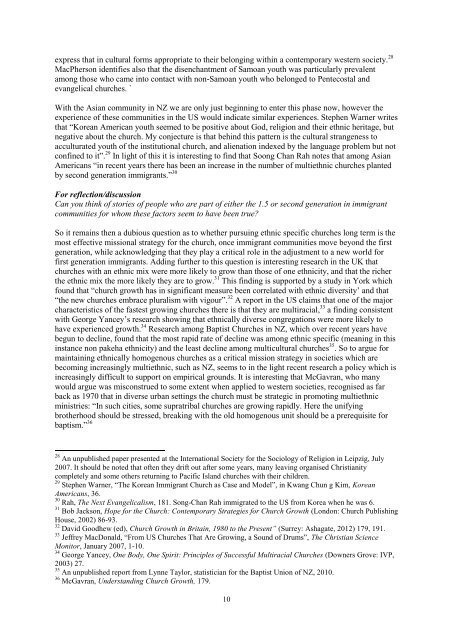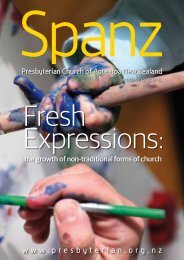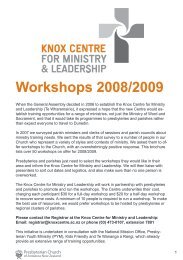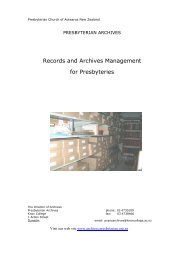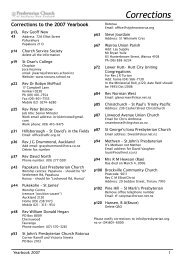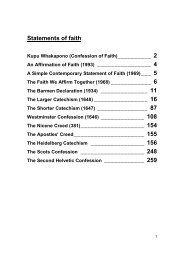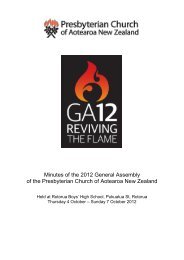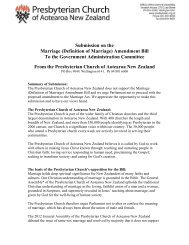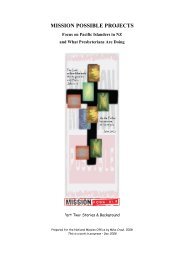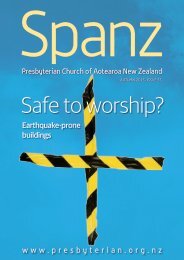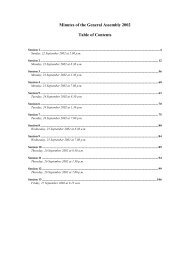Cultural diversity and unity in Christ: the Presbyterian Church of ...
Cultural diversity and unity in Christ: the Presbyterian Church of ...
Cultural diversity and unity in Christ: the Presbyterian Church of ...
You also want an ePaper? Increase the reach of your titles
YUMPU automatically turns print PDFs into web optimized ePapers that Google loves.
express that <strong>in</strong> cultural forms appropriate to <strong>the</strong>ir belong<strong>in</strong>g with<strong>in</strong> a contemporary western society. 28<br />
MacPherson identifies also that <strong>the</strong> disenchantment <strong>of</strong> Samoan youth was particularly prevalent<br />
among those who came <strong>in</strong>to contact with non-Samoan youth who belonged to Pentecostal <strong>and</strong><br />
evangelical churches. `<br />
With <strong>the</strong> Asian comm<strong>unity</strong> <strong>in</strong> NZ we are only just beg<strong>in</strong>n<strong>in</strong>g to enter this phase now, however <strong>the</strong><br />
experience <strong>of</strong> <strong>the</strong>se communities <strong>in</strong> <strong>the</strong> US would <strong>in</strong>dicate similar experiences. Stephen Warner writes<br />
that “Korean American youth seemed to be positive about God, religion <strong>and</strong> <strong>the</strong>ir ethnic heritage, but<br />
negative about <strong>the</strong> church. My conjecture is that beh<strong>in</strong>d this pattern is <strong>the</strong> cultural strangeness to<br />
acculturated youth <strong>of</strong> <strong>the</strong> <strong>in</strong>stitutional church, <strong>and</strong> alienation <strong>in</strong>dexed by <strong>the</strong> language problem but not<br />
conf<strong>in</strong>ed to it”. 29 In light <strong>of</strong> this it is <strong>in</strong>terest<strong>in</strong>g to f<strong>in</strong>d that Soong Chan Rah notes that among Asian<br />
Americans “<strong>in</strong> recent years <strong>the</strong>re has been an <strong>in</strong>crease <strong>in</strong> <strong>the</strong> number <strong>of</strong> multiethnic churches planted<br />
by second generation immigrants.” 30<br />
For reflection/discussion<br />
Can you th<strong>in</strong>k <strong>of</strong> stories <strong>of</strong> people who are part <strong>of</strong> ei<strong>the</strong>r <strong>the</strong> 1.5 or second generation <strong>in</strong> immigrant<br />
communities for whom <strong>the</strong>se factors seem to have been true?<br />
So it rema<strong>in</strong>s <strong>the</strong>n a dubious question as to whe<strong>the</strong>r pursu<strong>in</strong>g ethnic specific churches long term is <strong>the</strong><br />
most effective missional strategy for <strong>the</strong> church, once immigrant communities move beyond <strong>the</strong> first<br />
generation, while acknowledg<strong>in</strong>g that <strong>the</strong>y play a critical role <strong>in</strong> <strong>the</strong> adjustment to a new world for<br />
first generation immigrants. Add<strong>in</strong>g fur<strong>the</strong>r to this question is <strong>in</strong>terest<strong>in</strong>g research <strong>in</strong> <strong>the</strong> UK that<br />
churches with an ethnic mix were more likely to grow than those <strong>of</strong> one ethnicity, <strong>and</strong> that <strong>the</strong> richer<br />
<strong>the</strong> ethnic mix <strong>the</strong> more likely <strong>the</strong>y are to grow. 31 This f<strong>in</strong>d<strong>in</strong>g is supported by a study <strong>in</strong> York which<br />
found that “church growth has <strong>in</strong> significant measure been correlated with ethnic <strong>diversity</strong>’ <strong>and</strong> that<br />
“<strong>the</strong> new churches embrace pluralism with vigour”. 32 A report <strong>in</strong> <strong>the</strong> US claims that one <strong>of</strong> <strong>the</strong> major<br />
characteristics <strong>of</strong> <strong>the</strong> fastest grow<strong>in</strong>g churches <strong>the</strong>re is that <strong>the</strong>y are multiracial, 33 a f<strong>in</strong>d<strong>in</strong>g consistent<br />
with George Yancey’s research show<strong>in</strong>g that ethnically diverse congregations were more likely to<br />
have experienced growth. 34 Research among Baptist <strong>Church</strong>es <strong>in</strong> NZ, which over recent years have<br />
begun to decl<strong>in</strong>e, found that <strong>the</strong> most rapid rate <strong>of</strong> decl<strong>in</strong>e was among ethnic specific (mean<strong>in</strong>g <strong>in</strong> this<br />
<strong>in</strong>stance non pakeha ethnicity) <strong>and</strong> <strong>the</strong> least decl<strong>in</strong>e among multicultural churches 35 . So to argue for<br />
ma<strong>in</strong>ta<strong>in</strong><strong>in</strong>g ethnically homogenous churches as a critical mission strategy <strong>in</strong> societies which are<br />
becom<strong>in</strong>g <strong>in</strong>creas<strong>in</strong>gly multiethnic, such as NZ, seems to <strong>in</strong> <strong>the</strong> light recent research a policy which is<br />
<strong>in</strong>creas<strong>in</strong>gly difficult to support on empirical grounds. It is <strong>in</strong>terest<strong>in</strong>g that McGavran, who many<br />
would argue was misconstrued to some extent when applied to western societies, recognised as far<br />
back as 1970 that <strong>in</strong> diverse urban sett<strong>in</strong>gs <strong>the</strong> church must be strategic <strong>in</strong> promot<strong>in</strong>g multiethnic<br />
m<strong>in</strong>istries: “In such cities, some supratribal churches are grow<strong>in</strong>g rapidly. Here <strong>the</strong> unify<strong>in</strong>g<br />
bro<strong>the</strong>rhood should be stressed, break<strong>in</strong>g with <strong>the</strong> old homogenous unit should be a prerequisite for<br />
baptism.” 36<br />
28 An unpublished paper presented at <strong>the</strong> International Society for <strong>the</strong> Sociology <strong>of</strong> Religion <strong>in</strong> Leipzig, July<br />
2007. It should be noted that <strong>of</strong>ten <strong>the</strong>y drift out after some years, many leav<strong>in</strong>g organised <strong>Christ</strong>ianity<br />
completely <strong>and</strong> some o<strong>the</strong>rs return<strong>in</strong>g to Pacific Isl<strong>and</strong> churches with <strong>the</strong>ir children.<br />
29 Stephen Warner, “The Korean Immigrant <strong>Church</strong> as Case <strong>and</strong> Model”, <strong>in</strong> Kwang Chun g Kim, Korean<br />
Americans, 36.<br />
30 Rah, The Next Evangelicalism, 181. Song-Chan Rah immigrated to <strong>the</strong> US from Korea when he was 6.<br />
31 Bob Jackson, Hope for <strong>the</strong> <strong>Church</strong>: Contemporary Strategies for <strong>Church</strong> Growth (London: <strong>Church</strong> Publish<strong>in</strong>g<br />
House, 2002) 86-93.<br />
32 David Goodhew (ed), <strong>Church</strong> Growth <strong>in</strong> Brita<strong>in</strong>, 1980 to <strong>the</strong> Present” (Surrey: Ashagate, 2012) 179, 191.<br />
33 Jeffrey MacDonald, “From US <strong>Church</strong>es That Are Grow<strong>in</strong>g, a Sound <strong>of</strong> Drums”, The <strong>Christ</strong>ian Science<br />
Monitor, January 2007, 1-10.<br />
34 George Yancey, One Body, One Spirit: Pr<strong>in</strong>ciples <strong>of</strong> Successful Multiracial <strong>Church</strong>es (Downers Grove: IVP,<br />
2003) 27.<br />
35 An unpublished report from Lynne Taylor, statistician for <strong>the</strong> Baptist Union <strong>of</strong> NZ, 2010.<br />
36 McGavran, Underst<strong>and</strong><strong>in</strong>g <strong>Church</strong> Growth, 179.<br />
10


